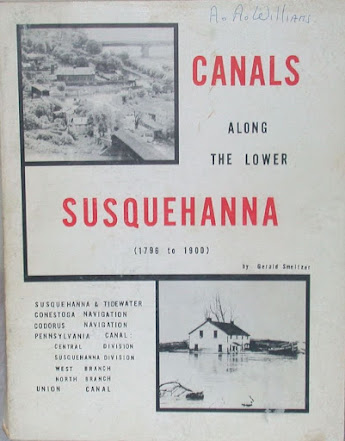
An Index Of Stories, History, Photos, and Resources, related to the Canal along the Susquehanna River, particularly in the area of the North and West Branch.
Note - the above photo is used on a variety of postcards. I've seen it labeled Milton Pa, Jersey Shore Pa, Rochester NY, 1840, ... The image is a painting by Edward Lamson Henry [E.L. Henry] 1841-1919 titled “Before the Days of RapidTransit”. It shows a Packet Boat on the Erie Canal being pulled by a team of horses on the canal bank.
|
|
|
|
|
|
|
|
===========
Boatyards
===========
|
|
In March of 1872, this boat yard was owned by McCarthy, Keller & Co. |
|
===========
Memoirs & Mentions
==============
|
Milton By J.P. Kohler |
by Mrs. Hazel Whitenight, Lime Ridge School |
|
|
|
|
|
At the 1921 reunion, canal men recalled falling asleep while driving mules, and being awakened suddenly when they struck chilly waters. They spoke of being picked on by tough gangs in the coal regions and of the temptations of passing by orchards.
The Pennsylvania Grit reported:
Captain William Courson of Epsy recounted a story of a little colored boy who was driving mules for him one very story night, and who pleased somewhat in this manner to be taken on the boat:
"Mister Courson, I-I- certainly can't stand this kind of weather like a white boy". On another occasion when the water in the canal had overflowed a low place in the towpath, the little fellow came running back and said "Mister Courson, the towpath done got all." -
============
The Boatmen's Reunions
=============
The Boatmen's Reunions
=============
|
|
Boating On The Canal - Yesteryears Column by Agnes Selin Schoch, 1949 |
|
====================
Susquehanna Jack, the storyteller of Frontier Pennsylvania demonstrating a horn used on Canal Boats, at the Degenstein History Buffs this afternoon. Captains would use the horn to alert the lock tenders that they were approaching, so that they could get the lock gates ready.
See the video here -
=====================
Parks & Remnants
Where The History Can Still Be Seen Locally
==================
Muncy Heritage Park - A variety of historical markers, remnants, and a nice walking trail -
The Canal Path At Watsontown
Canal Path in Danville Pa
[North Branch Canal]
Diorama at the Taber Museum in Williamsport
Historical Marker In Milton
Historical Marker along the Susquehanna Riverwalk in Williamsport
[Note To Self - Find and Add Photos]
Large Stone Canal Markers at Fort Augusta
Canal Display at Watsontown Historical Association
==============
Books & Other Resources:
Amazing Pennsylvania Canals by W. H. Shank
[I have not read this myself]
"Since he first published this book in 1960, Mr. Shank has become one of the leading authorities on historic canals in the Northeastern United States. The author has included a statewide canal map, 125 historic photos, drawings by the late Philip Hoffman, a four-color cover and tables of lock and mileage data. As founder of the Pennsylvania Canal Society and past president of the American Canal Society, the author offers this definitive work on Pennsylvania canals with the help of canal buffs throughout the Keystone state."
Canals Along the Lower Susquehanna (1796 to 1900) By Gerald Smelzer
[I have not read this myself]
=============
The West Branch Canal
By Homer Folk
"In 1829, the Muncy Line of the West Branch of the Pennsylvania Canal was started. With pick and shovel, wheelbarrows, dump wagons, and horses pulling scoops or drag lines, tremendous manpower and horsepower produced a continuous ditch with water that connected the remote parts of Pennsylvania with the cities of the east.
The standard dimensions of the canal in its cross section, termed the ”prism”, were a width of forty feet at top waterline, twenty-eight at the bottom, and a minimum depth of four feet. The chosen route through Milton had a constant sea level reading until near Cameron Avenue. There the elevation dropped, making a lock with a lift of 6.12 feet necessary. Stone walls held together with hydraulic cement (select limestone burned with clay) were one hundred and twenty feet long, with a passageway seventeen feet wide. Miter or angular joints on the inner edge of the heavy wooden gates located at each end of the lock sealed the gates, with little water loss when the gates were closed. The large square balance beams were manually operated to close the gates. The lock tender, who lived in the state house (lock tender’s house), was responsible for operating the gates.
To the west of the canal was the former Limestone Run creek bed . From this source and the marsh to the west of the bed, an unlimited amount of clay was available for the puddling operation, necessary to make the canal bed nearly waterproof. Sand, gravel, shale and other types of porous soils made puddling necessary. Clay was not always so available, sometimes it had to be hauled from miles away, chopped fine with narrow spades, mixed with water until it was pliable, and then worked into the natural soil or built up soil. Additional layers were applied until the clay puddle was two to three feet thick.
After much laborious work during 1828, 1829 and 1830, the canal was put into use in November 1830. Its use that year was short. With the coming of winter and the first ice on the canal, the boats were made ready for winter."
==========
MAPS
===========
Pennsylvania Canal Map Books:
===================













.jpg)

.jpg)


.jpg)
.jpg)







No comments:
Post a Comment
I'll read the comments and approve them to post as soon as I can! Thanks for stopping by!